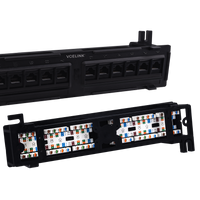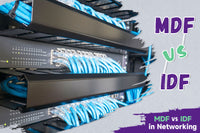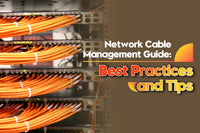High-speed network transmissions over long distances are not achieved solely through cables; they also rely on switches and other equipment. Whether in server rooms or data centers, structured cabling is very paramount for an efficient data flow. Consequently, an intermediate distribution frame (IDF) is needed to accommodate network devices and serves as a bridge from the main distribution frame (MDF) to individual cable lines. Intermediate distribution frames provide flexibility in network topology and act as telecom hubs within a certain area. They are often found in large buildings and facilities, typically in the form of small telecommunication rooms. This article offers a deep exploration of the IDF room.
What is IDF Room?
An IDF room is a centralized node covering telecommunications cables and equipment, used to distribute data. The intermediate distribution frame is usually located in a limited or specific area, e.g. a floor in a large building. Consisting of a frame to organize cables, an IDF room is connected to the main distribution frame (MDF) via Ethernet or fiber optic cables and distributes data to every end-user device within its coverage. As a key distribution point in this area, the IDF room helps enhance the network reach and facilitate the setup and management of network equipment and cabling.
IDF room acts as the central hub between MDF and end-user devices, minimizing the transmission distance and reducing signal attenuation. Localized management also facilitates targeted network expansion and efficient handling of network issues in specific areas. The IDF room enhances network performance and helps maintain a stable network.
4 Factors to Consider When Designing IDF Rooms
The IDF room is a central hub on the building floor, requiring strategic planning and design. Considering the layout, environment and other factors of planning IDF room is conducive to the network deployment. Here are some essential factors that you should consider before establishing an IDF room.
Location
The IDF room layout is critical to achieving optimal performance. Ideally, the IDF room should be located in the center of the floor, close to the shaft, with IDF rooms of different floors aligned vertically. The maximum running length of Ethernet cables is 100 meters (328 feet), so it is essential to make sure that the distance between the IDF room and access points does not exceed this limit. The shorter Ethernet cable runs achieve faster data transmission speeds and lower costs. In buildings covering huge areas, it may require more than one IDF per floor. Additionally, IDF rooms should have direct access to the public corridor for the convenience of technicians.
Capacity and Ventilation
The size and capacity of an IDF room depend on the serving area and the organization's specific needs. The size and number of racks and patch panels also rely on the scale of the network. It should be noted that IDF cabinets should not only meet your current requirements for data processing, storage, and security, but also accommodate future growth. A space of 8,000 square feet typically requires a 10 ft. x 10 ft. IDF room.
Another factor you need to consider is the air circulation within IDF rooms. Overheating of network equipment can not only affect the data transmission but also cause damage to the devices. Make sure that your IDF rooms are equipped with a reliable HVAC system to maintain the proper temperature and airflow.
Power
If you’re going to set up an IDF room in the existing area, it’s essential to hire an electrician to change the power capacity. But if you intend to build a new IDF room, assess the power requirements in advance. This assessment may involve calculating wattage consumption, planning circuit wiring, and adding redundant power supplies to ensure power distribution. In general, it could be safer to opt for 220V outlets than 110V power outlets, especially when dealing with high power consumption, or preparing future increases in power demand.
Environment
The IDF room has a high requirement for the environment. It is recommended to maintain the temperature between 18°C and 27°C, with relative humidity ranging from 30% to 55%. IDF rooms should be carefully arranged so that they can be protected from extreme temperatures, moisture, and dust. Scientific ventilation systems and cooling measures are necessary to maintain the proper environment. Moreover, all equipment and cables should be placed in order to facilitate cleaning and cooling processes.
The floor should be sealed to eliminate dust and static electricity. In terms of lighting, the IDF room should reach an illumination of at least 500 lx. The doors and interiors of IDF rooms should be made of fire-proof materials and equipped with fire detectors and fire extinguishers to prevent fire.
Good IDF Room Requirements
A good IDF room should satisfy different requirements, including essential components, security, redundancy, cable management, maintenance, etc.
- Some components are essential for an IDF room, including server racks and cabinets, patch panels, network switches, and cable management accessories. Patch panels play a crucial role in the IDF room, making it convenient to connect and disconnect patch cables. The IDF network switchesare used to connect end-user devices to the network. Depending on different requirements, an IDF room may house other network infrastructure devices, such as routers, ISP modems, hubs, firewalls, PoE switches, and servers.
- Proper security measures are also needed in the IDF room. It is wise to install CCTV cameras around IDF rooms to monitor suspicious behavior and create logs to record the time and visits.
- Backup and redundancy help avoid outages and data loss. This includes backing up data via hard disk drives, ensuring backup of power supplies, and maintaining redundancy of hardware devices. Uninterruptible power supplies (UPS) provide emergency power to the serving area during a power outage, while redundant hardware and automatic switching systems enable rerouting to alternative devices to avoid downtime.
- Cabling is a big challenge in IDF rooms. The cables should be properly managed to avoid being messy and dragged on the floor. In addition, clear labels should be attached to both ends of the cable to indicate their purpose and destination.
Regular maintenance also benefits a lot to the IDF room. Detailed documentation including network diagrams, equipment specifications, and logs of all maintenance activities is needed for the IDF room. You should carry out regular inspections and cleaning to remove dust and contaminants and ensure that equipment and cables are maintained in optimal condition. Also, remember to timely replenish coolant, replace damaged or near-life devices and cables, and upgrade outdated ones.

Differences Between IDF and MDF
MDF is the transition point between the external and internal networks. It houses core devices such as main routers and servers. Its main function is to centrally manage all networks and distribute data to nearby devices and each IDF. IDF is an intermediate node between remote end-user devices and MDF, covering specific floors or areas and connecting them to the network. IDF and MDF have different functions and characteristics. For more information about IDF and MDF, please check out our blog: MDF vs. IDF.
Final Thoughts
An IDF room is more than just a place for housing network cables and equipment; it serves as a critical hub for an efficient and well-organized network. Investing time and resources to properly design, implement, and maintain an IDF room will have long-term benefits. IDFs are vital for various environments, such as data centers, large offices, and buildings for reliable, scalable, and stable data communications.
FAQs
What should I consider when planning an IDF room?
You need to figure out the network requirements and carefully plan to achieve optimal network performance. You should consider the location and internal layout, ventilation, cooling, security, and fire protection. In addition, try to create a comfortable work environment for technicians by ensuring accessibility and minimizing noise.
What is the purpose of an IDF room?
The IDF room securely manages the local network, enhancing connectivity in a particular area within the facility.
Why are IDF rooms important in large buildings or on campuses?
The IDF room centralizes cables in a specific area, ensuring efficient network distribution and easy network management.
For more information on this topic, you can keep up on our blogs. While VCELINK offers general and basic information for our customers and other visitors to the website, it’s not professional advice.






Be the first one to comment.
Leave a comment